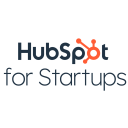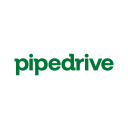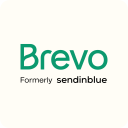ActiveCampaign vs HubSpot: Choosing the right marketing tool for your business
- 01ActiveCampaign vs HubSpot: overview
- 02What's the difference between ActiveCampaign and HubSpot?
- 03ActiveCampaign pros and cons
- 04HubSpot pros and cons
- 05ActiveCampaign compared to HubSpot
- 06HubSpot compared to ActiveCampaign
- 07Features comparison
- 08ActiveCampaign vs HubSpot: Which is the best for your business?
- 09Promotions on Email Marketing software
- 10Alternatives to ActiveCampaign & HubSpot
Access up to $1,610 savings on ActiveCampaign & $7,000 on HubSpot
HubSpot
75% off for 1 year
Access up to $1,610 savings on ActiveCampaign & $7,000 on HubSpot
Effectively managing customer relationships and creating compelling email campaigns are vital to growing a business. Digital marketing tools offer an ideal way to automate contact and email management, nurture leads, and personalize email sequences. But with multiple solutions available, picking the best one for your business can feel overwhelming.
In this in-depth comparison, we look at ActiveCampaign vs HubSpot, two industry giants in the CRM and email marketing space. Looking at their key features, we highlight how each tool addresses different business needs. Whether you manage a small business or a large enterprise, this article will help you make the right choice.
ActiveCampaign vs HubSpot: overview
ActiveCampaign and HubSpot are prominent contenders in the world of marketing automation software and CRM systems, each bringing a unique set of features and capabilities to the table.
ActiveCampaign shines with its automation prowess and advanced email marketing capabilities. It provides users with a robust platform for creating intricate automated workflows, segmenting contacts, and conducting A/B testing to optimize email campaigns. On the other hand, HubSpot offers a comprehensive suite of marketing, sales, and customer service tools, making it an all-in-one solution for inbound marketing. It caters to businesses of all sizes, from startups to enterprises, with features like CRM, marketing automation, email marketing, social media management, and customer support.
Now, let's delve into the ActiveCampaign vs. HubSpot comparison to help you make an informed decision about selecting the right marketing automation and CRM solution for your specific business needs.
What's the difference between ActiveCampaign and HubSpot?


While ActiveCampaign and HubSpot share common CRM and email marketing features, they have several key differences. The main distinction lies in the focus and scope of their integrated tools. ActiveCampaign serves as an email marketing automation platform with a strong sales focus, supported by a dedicated CRM. As a result, it offers advanced email marketing functionality. Accessing ActiveCampaign’s CRM requires a subscription to its sales plan or combined sales/marketing bundle. On the other hand, HubSpot is a CRM platform offering several other hubs, including marketing, sales, service, operations, content management, and commerce. HubSpot automatically includes its CRM in most of its hubs, which integrate seamlessly with each other. This makes HubSpot a good tool for sharing information between departments.
Email limits are another key difference between ActiveCampaign and HubSpot. ActiveCampaign generously offers unlimited email sends for up to 250,000 contacts on all its plans. Compared to ActiveCampaign, HubSpot Marketing Hub limits email sends. For example, the free plan includes 2,000 email sends per month, with send limits for other plans determined by the marketing contact tier. HubSpot Marketing Hub also limits contacts. Its paid plans for individuals (Starter) and teams (Professional) include up to 1,000 and 2,000 marketing contacts, respectively. Its Professional plan includes 2,000 contacts, while its Enterprise offers 10,000. You can also add further contacts for an additional price.
Minor differences exist across other features, such as contact management. For example, HubSpot allows you to add multiple addresses for one contact, whereas ActiveCampaign doesn’t. According to the site EmailTooltester, the platform’s deliverability rates also vary. When tested, HubSpot’s deliverability rate was 76.53%, while ActiveCampaign’s was 92.03%. One or more of these factors may guide your choice of the best tool for your business.
ActiveCampaign pros and cons
What are the advantages of ActiveCampaign?
- Advanced automation: ActiveCampaign is renowned for its powerful automation capabilities. It allows you to create complex and highly customized automation workflows that can nurture leads, segment contacts, and trigger actions based on user behavior.
- Email marketing excellence: ActiveCampaign offers robust email marketing tools, including dynamic content, A/B testing, and personalized email sequences. This makes it a valuable platform for creating and optimizing email campaigns.
- CRM integration: It includes a built-in customer relationship management (CRM) system, helping you manage contacts, track interactions, and gain insights into your customer relationships without the need for third-party integrations.
- Analytics and reporting: ActiveCampaign provides in-depth analytics and reporting features, allowing you to track the performance of your marketing campaigns and automation sequences. This data-driven approach helps you make informed decisions for optimization.
- Third-party integrations: ActiveCampaign supports a wide range of third-party integrations, enabling you to connect it with other tools and services you already use in your business, such as e-commerce platforms and analytics tools.
What are the disadvantages of ActiveCampaign?
- Learning curve: Due to its extensive features and capabilities, ActiveCampaign can have a steep learning curve, particularly for beginners. Users may require time to fully harness its potential.
- Pricing: While it offers competitive pricing, some users may find the cost of ActiveCampaign to be higher compared to simpler email marketing solutions, especially as their contact lists grow.
- Template design: While it offers customization, some users may find the template design options to be less visually appealing and flexible compared to other email marketing platforms.
- Complexity for small businesses: Small businesses with straightforward email marketing needs may find ActiveCampaign's feature set overwhelming and may not fully utilize its capabilities.
- Customer support: While ActiveCampaign offers customer support, some users have reported mixed experiences with responsiveness and resolution of issues. The quality of support may vary.
Compare ActiveCampaign to other tools
HubSpot pros and cons
What are the advantages of HubSpot?
All-in-one solution: HubSpot offers a comprehensive suite of marketing, sales, and customer service tools, providing businesses with an integrated platform to manage various aspects of their customer journey.
User-friendly: HubSpot is known for its user-friendly interface and intuitive tools, making it accessible to users with varying levels of technical expertise.
Powerful CRM: The HubSpot CRM is robust and free to use, offering contact management, lead tracking, and integration with marketing and sales tools, allowing businesses to maintain organized customer records.
Inbound marketing focus: HubSpot is a pioneer in inbound marketing, and its tools are designed to help businesses attract, engage, and delight customers through content marketing, SEO, and social media.
Extensive education: HubSpot provides a wealth of educational resources, including certifications, courses, and a thriving community, which can be beneficial for users looking to improve their marketing and sales skills.
What are the disadvantages of HubSpot?
- Pricing: HubSpot's pricing can be relatively high for small businesses, especially if they require advanced features or have a large contact database.
- Learning curve: While HubSpot is user-friendly, its vast array of features and options can still present a learning curve for some users, particularly those new to marketing automation.
- Limited customization: Some users may find that HubSpot's templates and design options for emails and webpages are somewhat restrictive compared to other platforms.
- Dependency on ecosystem: As an all-in-one solution, HubSpot users may feel somewhat locked into the HubSpot ecosystem, which can limit their flexibility when it comes to integrating with other tools.
- Customer support response time: Some users have reported longer response times from HubSpot's customer support team, particularly for users on lower-tier plans. This can be a drawback when immediate assistance is needed.
Compare HubSpot to other tools
ActiveCampaign compared to HubSpot
When comparing ActiveCampaign and HubSpot, ActiveCampaign distinguishes itself with its advanced marketing automation capabilities and robust email marketing features. It caters to users seeking intricate automation workflows, personalized email sequences, and in-depth lead nurturing. ActiveCampaign's strength lies in its ability to provide highly tailored and automated customer journeys.
The choice between ActiveCampaign and HubSpot depends on the depth of automation, customization, and integration requirements within your marketing and sales strategy. ActiveCampaign excels in its automation capabilities, while HubSpot offers a more extensive ecosystem of tools for managing various aspects of the customer experience.
Is ActiveCampaign better than HubSpot?
Determining whether ActiveCampaign is better than HubSpot hinges on your unique marketing and sales requirements. ActiveCampaign excels in providing advanced marketing automation capabilities and in-depth email marketing features. It's a preferred choice for users seeking intricate automation workflows and personalized communication at scale. Its strengths lie in delivering highly tailored and automated customer journeys.
On the other hand, HubSpot offers a comprehensive suite of marketing, sales, and customer service tools, making it an all-encompassing solution for managing the entire customer journey. The choice between ActiveCampaign and HubSpot depends on the depth of your automation needs, the breadth of your marketing and sales strategy, and your preference for an all-in-one ecosystem versus specialized automation capabilities.
What is ActiveCampaign best used for?
ActiveCampaign excels as a versatile marketing automation platform. It is best used for businesses seeking advanced automation capabilities, personalized customer journeys, and comprehensive email marketing. ActiveCampaign empowers users to create intricate automation workflows, segment contacts, and tailor communication based on user behavior. This makes it ideal for nurturing leads, optimizing email campaigns, and driving conversions.
With its robust CRM integration, it enables businesses to manage contacts and track interactions seamlessly. ActiveCampaign's strength lies in its ability to automate and streamline various marketing and sales processes, making it a valuable tool for businesses looking to enhance their customer engagement and automation efforts.
Can ActiveCampaign replace HubSpot?
Whether ActiveCampaign can replace HubSpot depends on the depth and scope of your marketing, sales, and customer service needs. ActiveCampaign shines in advanced marketing automation and personalized communication. It's well-suited for businesses seeking intricate automation workflows, lead nurturing, and email marketing optimization.
HubSpot, on the other hand, offers a comprehensive suite of tools covering marketing, sales, and customer service, making it an all-in-one solution for managing the entire customer journey. The decision between ActiveCampaign and HubSpot rests on the extent of your automation, CRM, and overall customer journey management requirements. ActiveCampaign excels in specialized automation, while HubSpot offers a broader ecosystem of tools for comprehensive customer engagement.
Is ActiveCampaign cheaper than HubSpot?
In terms of pricing, it's essential to highlight the distinctions between ActiveCampaign and HubSpot. ActiveCampaign’s pricing structure can be more cost-effective for businesses as it often focuses on the specific features and number of users you need. This flexibility can benefit businesses looking to tailor their expenses to their actual requirements.
In contrast, HubSpot employs a tiered pricing model that may become more costly as your needs expand. While HubSpot offers a free CRM and basic marketing tools, accessing advanced features and scaling up may entail higher expenses.
Is there a better Email Marketing software than ActiveCampaign?
While ActiveCampaign is highly regarded for its marketing automation capabilities, it's essential to consider whether there might be a more suitable software for your specific needs.
Several notable alternatives to ActiveCampaign in the marketing automation and CRM space include HubSpot, Salesforce Marketing Cloud, Brevo (ex. Sendinblue), and Marketing Cloud Account Engagement (ex. Pardot).
The choice of marketing automation software depends on your organization's unique goals, budget, and the extent of automation and CRM functionality you require. While ActiveCampaign excels in certain areas, other platforms may offer more extensive integrations, industry-specific solutions, or advanced analytics that align better with your automation and customer relationship management objectives.
90% off any annual plan for the first year on ActiveCampaign
Get 90% off any annual plan for the first year on ActiveCampaign and up to $1,610 savings with Secret.
HubSpot compared to ActiveCampaign
HubSpot distinguishes itself with its extensive suite of marketing, sales, and customer service tools, making it a compelling choice for organizations seeking an all-in-one platform. HubSpot's pricing structure offers a range of plans, including free options and various paid tiers, accommodating users with diverse marketing and sales needs, regardless of their budget.
While both HubSpot and ActiveCampaign excel in marketing automation and CRM, the choice between the two depends on your specific requirements. HubSpot provides an all-encompassing and scalable solution for businesses and marketers aiming to streamline their marketing, sales, and customer service efforts under a single platform. It's ideal for those looking to consolidate operations and access a wide array of integrated tools to enhance their customer engagement and automation capabilities.
Is HubSpot better than ActiveCampaign?
Determining whether HubSpot is better than ActiveCampaign centers on your specific marketing and sales needs and objectives. HubSpot stands out for its comprehensive suite of marketing, sales, and customer service tools, providing an all-in-one solution for businesses seeking a unified platform. If you prioritize having a consolidated ecosystem for your customer journey management, HubSpot may be the preferable choice.
However, it's essential to acknowledge that ActiveCampaign offers advanced marketing automation capabilities, making it an excellent choice for businesses requiring intricate automation workflows and personalized communication. If your primary focus is on advanced automation and email marketing, ActiveCampaign remains a compelling option.
What is HubSpot best used for?
HubSpot is a versatile and comprehensive marketing, sales, and customer service platform, making it best suited for businesses aiming to manage their entire customer journey in one place. It excels in inbound marketing, offering tools for content creation, SEO optimization, and social media management.
HubSpot's CRM integration enables contact management, lead tracking, and marketing automation. It's invaluable for businesses seeking to streamline their marketing, sales, and customer service efforts, providing a unified platform for nurturing leads, converting customers, and providing post-sale support. Additionally, HubSpot's analytics tools empower data-driven decision-making, making it an ideal choice for organizations prioritizing data-driven marketing strategies.
Can HubSpot replace ActiveCampaign?
Whether HubSpot can effectively replace ActiveCampaign depends on your specific marketing and sales needs. HubSpot provides a comprehensive suite of marketing, sales, and customer service tools, making it suitable for businesses seeking an all-in-one platform to manage their customer journey.
However, ActiveCampaign specializes in advanced marketing automation and personalized communication. If your primary focus is on intricate automation workflows, lead nurturing, and highly customized email marketing, ActiveCampaign may offer features and capabilities that align better with your marketing strategy.
Is HubSpot cheaper than ActiveCampaign?
When comparing the cost of HubSpot and ActiveCampaign, it's important to note that the pricing models differ significantly. HubSpot’s pricing typically offers a range of plans, including free options and various paid tiers, accommodating users with diverse marketing and sales needs. However, accessing advanced features and scaling up may entail higher expenses.
On the other hand, ActiveCampaign's pricing often depends on the specific features and number of users you require, potentially providing a more cost-effective choice, particularly for businesses aiming to optimize their expenses based on usage.
Is there a better Prospecting software than HubSpot?
While HubSpot is a robust and versatile marketing, sales, and customer service platform, it's essential to investigate whether there might be a more tailored software solution for your specific needs.
Several notable alternatives to HubSpot in the marketing and sales software space include ActiveCampaign, Zendesk, Marketo, and Freshworks.
The selection of marketing and sales software should align with your unique objectives, budget, and the depth of features required. While HubSpot offers an integrated ecosystem, other platforms may offer more specialized solutions, industry-specific tools, or advanced analytics that better match your marketing and sales strategy and goals.
75% off for 1 year on HubSpot
Get 75% off for 1 year on HubSpot and up to $7,000 savings with Secret.
Features comparison
ActiveCampaign and HubSpot are Equal at AI-Powered Sales Forecast

ActiveCampaign offers AI-powered predictive sales forecasting, enabling businesses to analyze past data and various scenarios to predict future sales accurately. For instance, it can use historical customer behavior and engagement data to forecast potential sales opportunities. This functionality helps businesses align their strategies with sales goals and make data-driven decisions.
HubSpot also provides AI-powered predictive sales forecasting with a similar approach to ActiveCampaign. It leverages historical data and predictive algorithms to generate forecasts and insights into future sales trends, ensuring businesses have a comprehensive overview of their sales opportunities.
HubSpot Excels Ahead of ActiveCampaign in User-Friendly Design
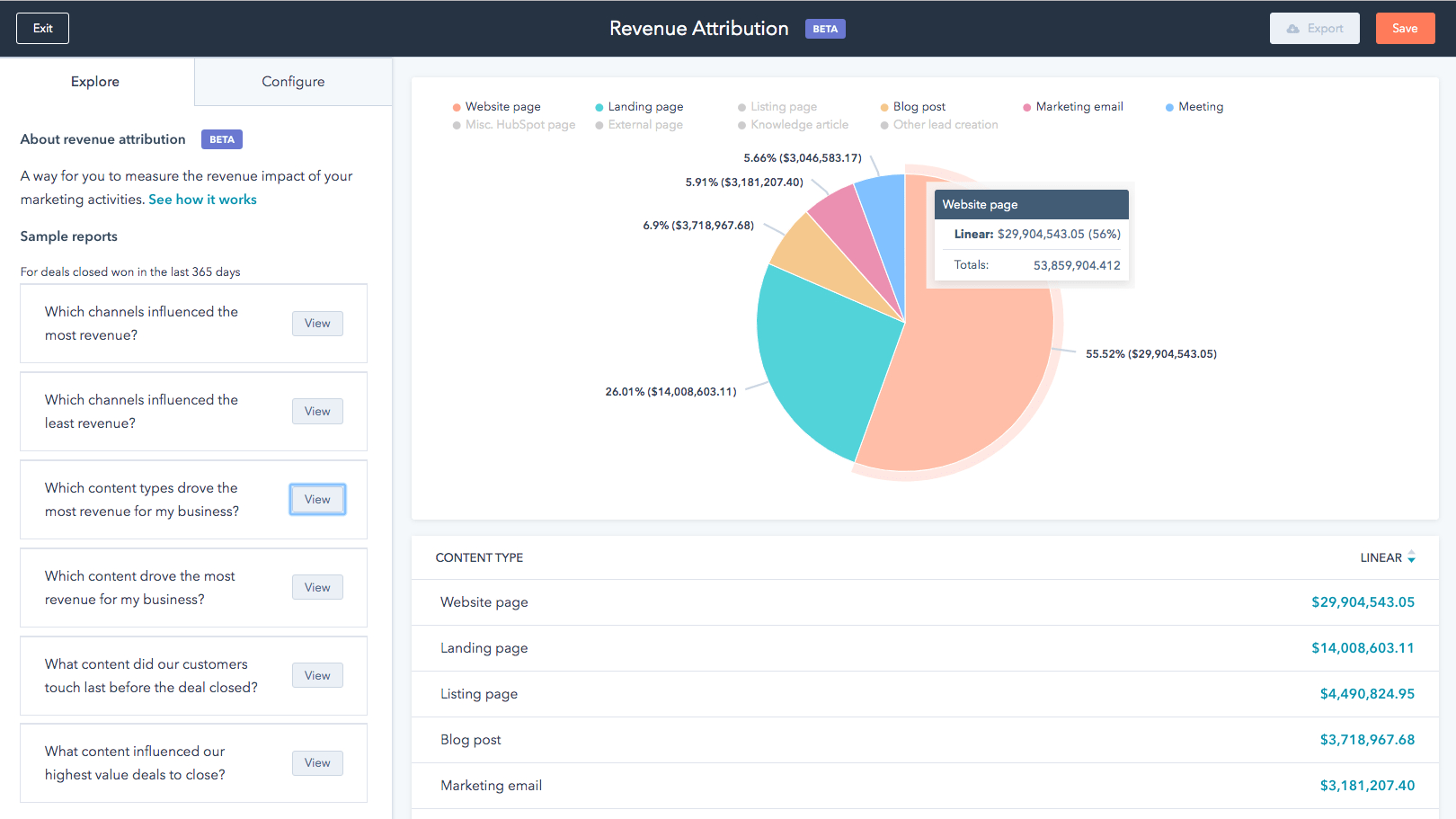
HubSpot is renowned for its user-centric design, making it a top choice for startups prioritizing ease of use. Its interface is easy to navigate, even for non-technical entrepreneurs. HubSpot's step-by-step introductory guide further streamlines the onboarding process, allowing startups to hit the ground running without a steep learning curve. For example, creating email campaigns or setting up lead nurturing workflows is intuitive in HubSpot.
ActiveCampaign, while robust, may pose a steeper learning curve. It's better suited for technically adept users or those with IT support teams. The platform's comprehensive features require some technical skills to navigate effectively. For instance, setting up complex automation workflows in ActiveCampaign may demand a deeper understanding of the tool's capabilities.
ActiveCampaign Offers Better Marketing Automation than HubSpot
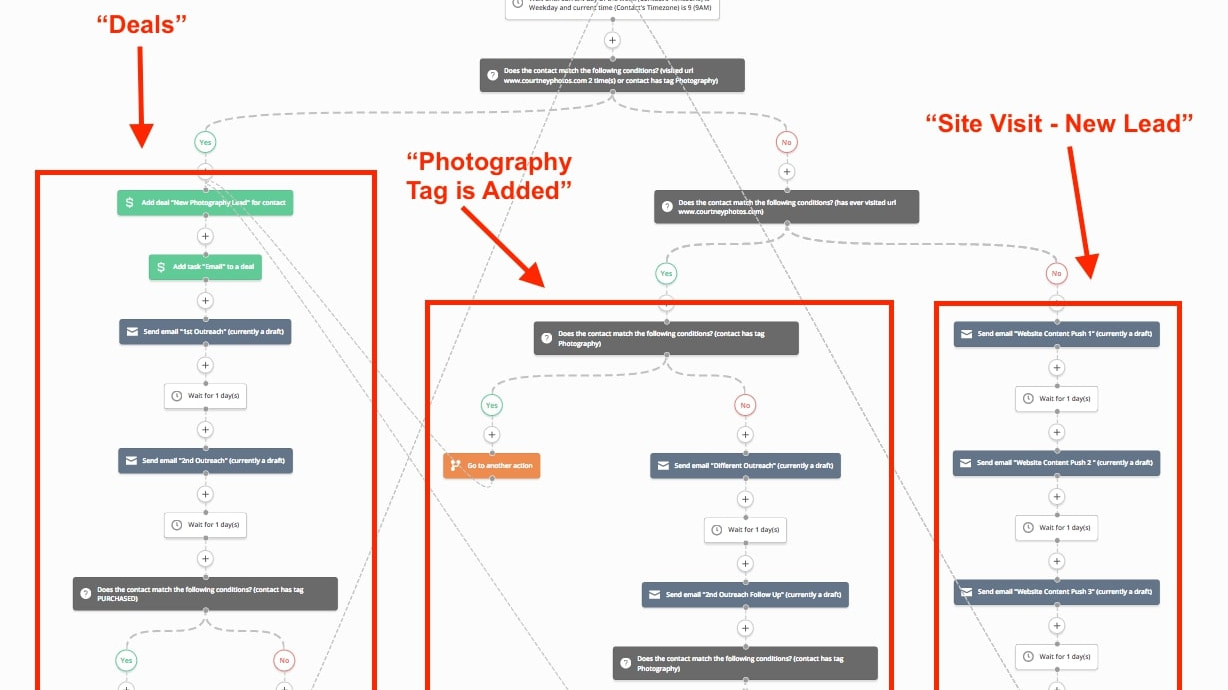
ActiveCampaign provides a robust platform for fine-tuned contact list management, precise segmentation, and powerful automation. Its standout feature is its ability to create highly customized workflows that cater to specific business needs. For instance, you can set up custom automation to trigger personalized follow-up emails based on user interactions, ensuring a tailored customer journey.
While HubSpot offers automation capabilities, they tend to be more standardized compared to ActiveCampaign. HubSpot's automation workflows are versatile but may not provide the same level of granularity and customization. Nevertheless, HubSpot is suitable for businesses seeking a broader set of tools for marketing, sales, and customer service, all within a unified platform.
HubSpots’s Impressive Integration Ecosystem Outperforms ActiveCampaign’s

HubSpot offers an even more extensive array of integrations, with over 1,400 options. This expansive integration ecosystem ensures that HubSpot can easily connect with a wide variety of tools and systems. For example, it integrates seamlessly with customer service platforms like Zendesk, accounting software such as QuickBooks, and social media management tools like Hootsuite.
ActiveCampaign, on the other hand, boasts a more limited, yet still extensive list of integrations, with over 870 tools available. It seamlessly connects with popular CRMs like Salesforce, e-commerce platforms such as Shopify, and communication tools like Slack, enhancing your workflow's efficiency.
HubSpot Excels in Sales Pipeline Management Compared to ActiveCampaign

HubSpot shines in this department with its intuitive sales pipeline management feature. It provides a clear visualization of the sales process, allowing users to set stages and milestones effortlessly. For example, you can easily create stages like "Prospecting," "Qualification," and "Closing" to track sales opportunities. This simplicity streamlines the process of moving deals through the pipeline, enhancing sales efficiency.
On the other hand, ActiveCampaign's CRM centralizes all customer and sales data efficiently. However, it may lag behind in intuitive pipeline management compared to HubSpot. While you can manage deals in ActiveCampaign, it might not offer the same level of ease and visual clarity as HubSpot's dedicated pipeline management tools.
HubSpot's Lead Scoring and Segmentation is Superior to ActiveCampaign

HubSpot offers a competitive advantage with its advanced lead scoring capabilities. It allows businesses to assign scores to leads based on their behavior and engagement. For instance, opening emails, visiting key webpages, or downloading resources can trigger lead score increases. This system enables businesses to effortlessly identify and prioritize valuable leads. It streamlines sales efforts by focusing on leads with higher scores, increasing the likelihood of conversion.
While ActiveCampaign also provides segmentation options, it doesn't offer the same robust lead scoring capabilities as HubSpot. ActiveCampaign's strength lies in its ability to segment leads based on various criteria like behavior, demographics, and engagement. This segmentation helps tailor marketing campaigns and messages to specific audience segments but may require additional manual effort for lead prioritization.
ActiveCampaign’s Email Advertising is More Personalized than HubSpot’s

ActiveCampaign’s conversational email marketing feature is a standout, offering personalized and targeted advertising. The tool allows businesses to engage their customers effectively, improving customer engagement and reducing bounce rates. In comparison, HubSpot offers sales email tracking but lacks the focus on personalizing email content that ActiveCampaign excels at.
While HubSpot offers sales email tracking, it may not emphasize personalizing email content to the same extent as ActiveCampaign. HubSpot's strength lies in tracking email opens, clicks, and responses to gauge customer engagement, which is valuable for sales teams but may not provide the same level of content personalization.
Subscribe to our newsletters.
No FOMO here. Stay up-to-date on all the latest deals and news with our monthly newsletter straight to your inbox like 113,000+ entrepreneurs (+ Get 10% off on on our Premium Membership!)
ActiveCampaign vs HubSpot: Which is the best for your business?
ActiveCampaign is the best tool for you if:
- Your email marketing strategy relies on intricate automated workflows to support in-depth lead nurturing
- You’re searching for a robust email marketing platform with a dedicated CRM to centralize data management, efficiently managing contacts and tracking their interactions
- Your digital marketing strategy prioritizes personalization and you want an email marketing tool that enables precise contact segmentation to send tailored emails to your audience
- You have large subscriber lists and are looking for a tool that offers generous or unlimited email sends
- You’re an experienced marketer who feels comfortable working with advanced features such as A/B testing, dynamic content, and comprehensive reports and analytics
HubSpot is the best tool for you if:
- You’re looking for an integrated platform to optimize your inbound marketing with features like email marketing, marketing automation, CRM, content creation, social media management, and customer support
- You’re interested in an all-in-one marketing, sales, and customer service solution to support every stage of the customer journey
- You own a small business and prefer a consolidated tool with basic marketing features and a free CRM
- Your marketing team has limited technical expertise and you’re seeking a user-friendly solution that doesn’t involve a steep learning curve to master the basics
- You’re in the market for a digital marketing tool that offers extensive educational resources to help improve your marketing and sales skills
Alternatives to ActiveCampaign & HubSpot
Promotions on Email Marketing software
Start saving on the best SaaS with Secret.
Secret has already helped tens of thousands of startups save millions on the best SaaS like ActiveCampaign, HubSpot & many more. Join Secret now to buy software the smart way.


